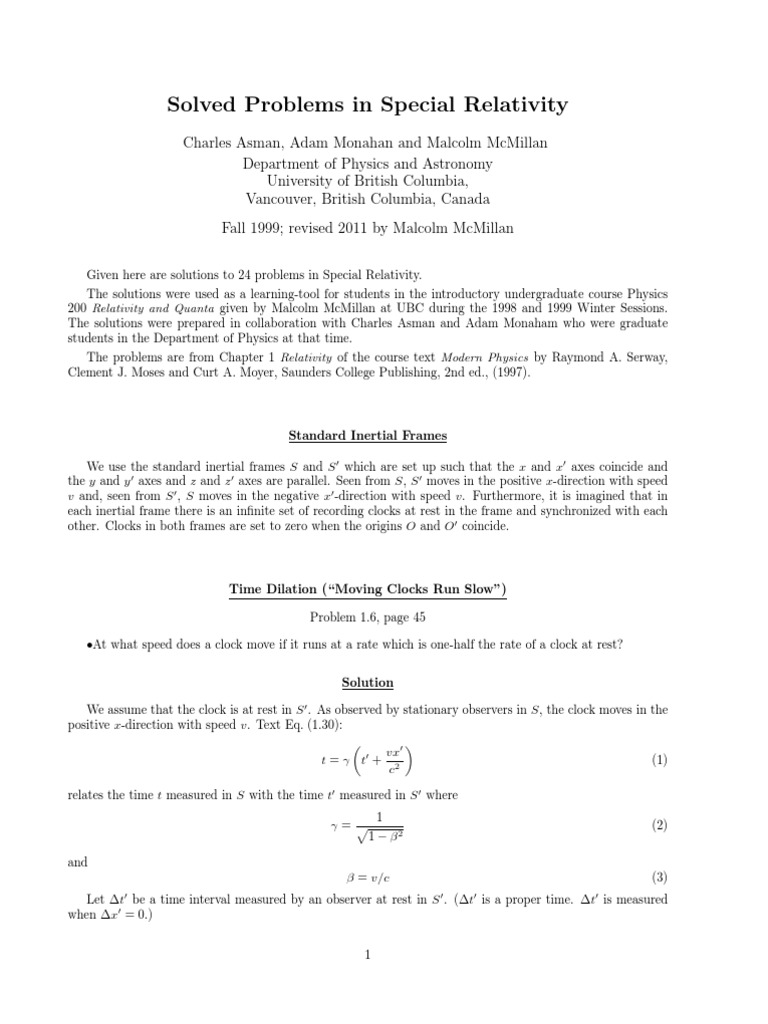In the realm of physical sciences, the doctrine of special relativity stands as a monumental pillar, reshaping our comprehension of time, space, and the fundamental structure of reality itself. Introduced by Albert Einstein in 1905, this revolutionary theory emerged from profound inquiry into the classical mechanics described by Newton, revealing intricate nuances that govern high-velocity phenomena. This article endeavors to explore the salient features of special relativity while unveiling the undercurrents that fuel society’s fascination with this profound theory.
1. Historic Context: The Birth of Special Relativity
The early 20th century marked a critical juncture in physics, characterized by a dissonance between classical mechanics and electromagnetic theory. At the heart of this discord was the notion that the speed of light remained constant irrespective of the observer’s motion. Prior to Einstein, many physicists grappled with the implications of this assertion, notably the work of James Clerk Maxwell, who formulated equations delineating electromagnetic fields. Einstein’s revolutionary postulates offered a cohesive framework that unified these disparate concepts, challenging prevailing paradigms and championing a new wave of scientific thought.
2. The Core Postulates of Special Relativity
Central to Einstein’s theory are two foundational postulates. The first asserts that the laws of physics are invariant across all inertial frames of reference; that is, the principles governing physical phenomena remain unchanged regardless of the uniform motion of observers. The second posits that the speed of light in a vacuum is constant—measured at approximately 299,792,458 meters per second—independent of the motion of the source or observer. These postulates led to a cascade of transformative implications that spectacularly altered our understanding of reality.
3. Time Dilation: A Paradoxical Phenomenon
One of the most astonishing consequences of special relativity is time dilation. As an object approaches relativistic speeds—close to the speed of light—time for that object appears to elapse slower when observed from a stationary frame. This phenomenon is not merely theoretical but has been confirmed through various empirical experiments. The classic example involves atomic clocks on high-speed jets. When compared to stationary counterparts, those in motion exhibit a measurable difference in elapsed time, thus challenging our intrinsic notions of temporal consistency.
4. Length Contraction: A Tangible Reality
Parallel to time dilation is the concept of length contraction, which posits that objects in motion experience a reduction in length as observed from a stationary frame. This contraction is more pronounced at relativistic speeds, thus challenging our intuitive understanding of measurement. When an object approaches the speed of light, its length in the direction of motion contracts, leading to bizarre conclusions about distances and spatial dimensions that defy classical geometrical principles.
5. Mass–Energy Equivalence: E=mc²
The relationship between mass and energy encapsulated in the famous equation E=mc² further elucidates the depth of special relativity’s implications. This equation asserts that mass and energy are interchangeable; a subtle transmutation that underlies nuclear fission and fusion—the very processes that power stars. The ramifications of this equivalence are monumental, extending not just to theoretical physics but into practical applications that underpin modern technological advancements.
6. The Fabric of Spacetime: A Paradigm Shift
Special relativity profoundly alters our conception of spacetime, merging the three spatial dimensions with time into a single continuum. This notion disintegrates classical separations, resulting in a holistic framework that enhances our understanding of the universe. Events are no longer merely described in sequential order but rather as interwoven occurrences relative to the observer’s frame of reference, urging a reexamination of causality and simultaneity.
7. Implications in Modern Physics: Beyond Classical Mechanics
The implications of special relativity extend beyond philosophy and theoretical physics into the realm of technologies that have reshaped contemporary society. Global Positioning System (GPS) technology, for instance, must accommodate relativistic effects to maintain accuracy in navigation. Moreover, particle physics experiments conducted at facilities such as CERN demonstrate the validity of special relativity, as particles are accelerated to velocities that evoke pronounced relativistic effects.
8. Cultural Fascination: The Allure of the Unknown
The enduring fascination with special relativity stems not merely from its scientific profundity but also from its philosophical ramifications. The interplay of time, space, and perception invites perennial inquiry into the nature of reality, consciousness, and human experience. As individuals contemplate the implications of traveling at relativistic speeds, they grapple with metaphysical questions about existence, continuity, and the very fabric of the universe itself. This philosophical dimension evokes an intrinsic allure, drawing enthusiasts beyond the confines of academia into an exploration of the cosmos.
9. The Future of Relativity: Continuing the Journey
As we navigate the complexities of modern physics, special relativity continues to inspire new discoveries and theoretical advancements. The integration of quantum mechanics and the quest for a unified field theory may someday illuminate further aspects of relativity, pushing the boundaries of human comprehension. In the tapestry of scientific progress, the journey through special relativity serves as a reminder of the mysteries that lie beyond our perception, forever beckoning us to explore the unknown.
In summary, special relativity transcends the confines of scientific understanding and weaves a narrative rich with intrigue and complexity. It challenges our perceptions, invites philosophical contemplation, and reshapes the landscapes of both theoretical inquiry and practical application. As we propel into the future, the lessons of special relativity will undoubtedly guide countless explorations into the uncharted territories of physics and beyond.












